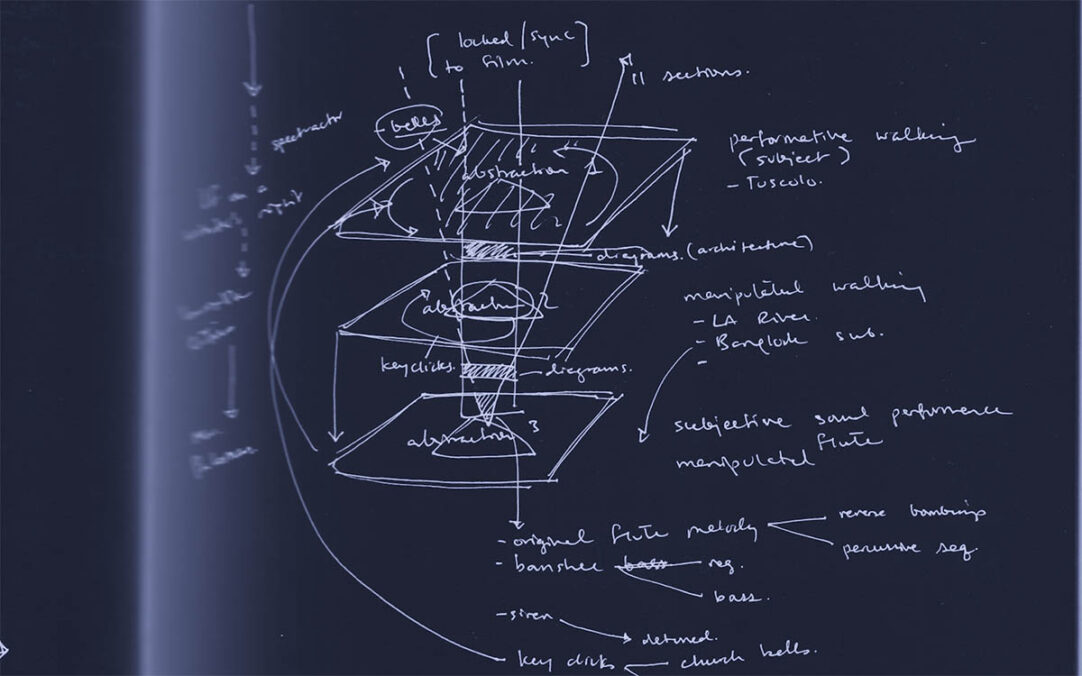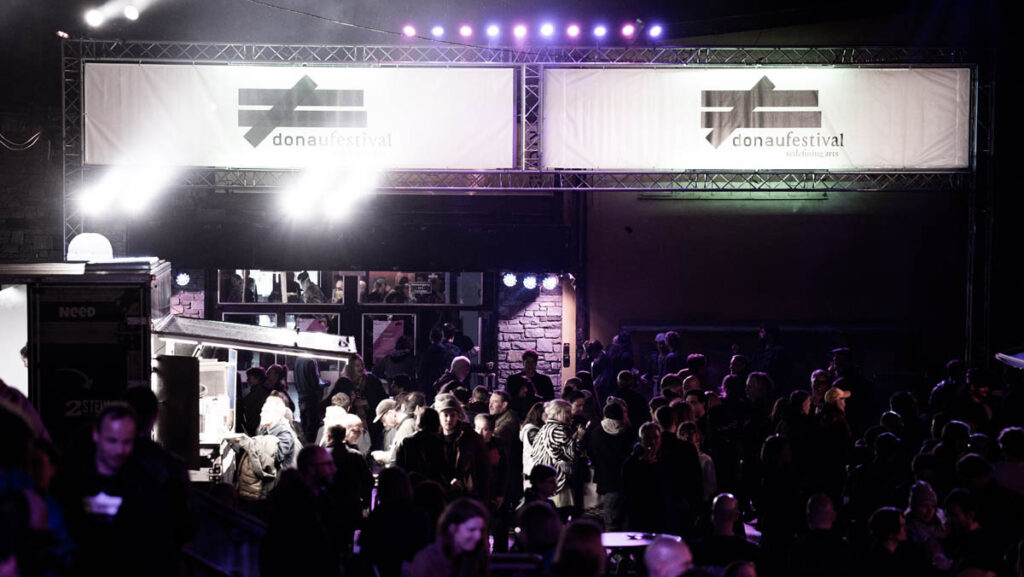
The installation interweaves the visual and the aural, the ephemeral and the physical, employing a triptychal, scalable configuration, folding and unfolding each layer, from the cities‘ sonic imprints, to the performative, relationally-modular video installation to the three copper sound sculptures.
How is it for you to come to the gallery and finally get to see your show coming to fruition?
It’s an incredible pleasure to see this exhibition come to fruition in Rome, albeit from afar. It has been a long but exciting journey that began years ago with my first encounter with Calvino through his novel If on a Winter’s night a Traveler, which my friend and composer, Anders T. Røshol, recommended to me. It instigated a long fascination with his work and led to me reading both Invisible Cities and Mr. Palomar, as well as several of his other works, including his essay Cybernetics and Ghosts. For some time now, I have been contemplating an exhibition project engaging with his work using both sound and image, so it was incredible to receive your invitation to create this installation for the AOC F58 Galleria Bruno Lisi in Rome following the celebration of his 100th anniversary last year and the large-scale exhibition at the Scuderie del Quirinale. Thank you again!

How else has that career in music composition for film dialogue with contemporary art impacted you as an artist?
I think the biggest impact my past in music composition for film has had on my work as an interdisciplinary artist is the awareness of contemporary vehicles of myth and their manipulation, particularly via the ‘invisible’ medium of sound (and music). Of course, though this is inherent in film itself as a medium and is apparent in films worldwide, it is particularly a tool of the Hollywood (and market-driven) system. I have become more and more engaged with the questioning of (and pushing back against) the imposed systems of myth and nomological linearities upon our thinking and perception and have strived for some time to find a way (and a medium or mediums) through which to explore this, going back time and again to the quote by Adorno from his biography of the composer Alban Berg of striving to ‘heighten illusion to the point of transparency’. A filmmaker like Michael Haneke does this with great profundity (and transparency) in my opinion and remains one of my favorites. On a relational note, perhaps because my journey in the arts began simultaneously with both visual and aural mediums (as well as movement: dance), the crux of my explorations always lies at the hinge of the two, embodied perhaps most powerfully in language itself, being both visual and aural, but also of course in such forms as opera, theatre, and film.
This exhibition is the first time I’ve been able to conceive and execute an installation that brings all these elements together and also engages (and contends) with the impact (and myth) of film, through the engagement with the three Calvino novels (If on a winter’s night a traveler, Invisible Cities and Mr. Palomar), bringing, like the Reader in Calvino’s If on a winter’s night a traveler, the spect-actor (public) into the work, confronting us with our own per/formative actions, our complicities in the systems and subjects in which we inhabit.

Installation View 2, photograph by Gabriele Mizzoni 
Vernissage, photograph by Gabriele Mizzoni
Can you introduce how the intersection of mediums is in your solo show? What does that process look like
This show brings together the visual, the aural, and movement (via live camera feed which analyzes the spect-actors movement in the space and impacts the movement of the sounds from the sculptures (subjects)). In a way, this is the same engagement that Calvino worked with through the medium of language, always an intersection of these three elements, here embodying it in both the level of the physical body and also the level of cities: themselves embodiments of the disembodied; from the city of Rome to the gallery as its city into the video which populates its inhabitants within its temporal architecture.
The process of course begins with the text, with which I’ve been gestating for years. For this work, I began by drawing and thinking through diagrams which often are how I first begin to explore ideas and concepts for a work. Perhaps this comes from my composition training writing scores and my ongoing fascination with graphic notation. In many ways, these diagrams are my scores for the project. The two important parts of my process (and I think any artwork) are the conceptual/contemplative and the physical/constructive. Both are forms of thinking and are also how I have always worked in sound mediums. From a construction standpoint, I respond best to tangible, physical materials so it helps to work with the physicalities of sound which is part of why I often love working with field recordings as I have done here as well.
The other very important element of my process in this exhibition in particular is my co-producer, avatar, and Max architectural engineer, Luc Trahand, who engineered the Max patch which is the architecture for the entire exhibit based on my various diagrams and our lengthy discussions and ongoing dialogue. This was of course a way of physically embodying the diagrams, concepts, and ideas, then allowing me to work with them tangibly. Luc brought a lot to the table from his knowledge of Max to his mathematical knowledge and his own experiences as an incredible sound artist/composer in his own right. We did a lot of versions of the patch architecture in my studio and once each version was a physical reality, I would be able to interact with them and ask for modifications which Luc would implement and make further suggestions on. Thus the process of creating the in/visible architecture itself was a process of per/forming each layer which would lead to its final—current—systemic form, inter-acted further by the spect-actors in the gallery in Rome.

Do you also keep the team around you?
That, of course, segues wonderfully into your question on the team. One of the things I’ve learned as a musician and also from working in film is the love of working with a team that I can trust, which adds richness to the process and work. This exhibition has been a fantastic example of that; the team is the size of small film production from the contributing performers Francesca Virginia Coppola, Prima Jalichandra-Sakuntabhai, object A.D, yourself Camilla and Kittiya Nivasanont, and flutist Cari Ann Souter to Luc to my technical consultants Chen Shen, Manop Buranapramest and Ken Goerres, Jean Hsi and Savika Goerres who helped shoot on location here in Los Angeles, Francesca who additionally was also invaluable both as associate producer and the translator of my texts into Italian to Simone Fanelli who created the plinths and equipment rack in Rome and was also the exhibition installer along with Luc himself and of course Emily and Zach of Reisig and Taylor Contemporary. I’m incredibly fortunate and thankful to have had such a great team around me, without whom this exhibition would not have been possible.
Art is not A PROFESSION, IT’S EXISTENCE, as CHRISTO explained. What do you think?
Yes, I agree. I would go further to say that Art, which is simply another physical embodiment of our ongoing need to question—to rend apart perception and form the perceived—just as the sciences are, is fundamentally human. After all, questioning is not only a human right but also a human responsibility.
Tell me about your involvement with Italo Calvino, and your ongoing solo show presented by Reisig and Taylor Contemporary [con objet A.D] at AOC F58 Galleria Bruno Lisi.
For me, it is important that engaging with other works of art, in this case literature, is not simply an attempt at translation because it is never possible of course to translate a text into another medium or form. My interest is to dig into the methodologies, structures, thoughts, and ideas of a work or set of works and engage with them from the present in time and place (and self). In this case, I was interested in the entanglements of subject and system, intersections of per/formative inter-actions, as present on multiple strata from self to cities to power structures (such as Myth and its contemporary vehicle Film) as well as the notion of abstraction being this inherently violent hinge between perception and the perceived. Thus, on several nested layers, both the visual and the aural aspects embody this: the video projection, for example, consists of layers of abstractions and distortions that keep spiraling until one eventually is confronted by its physical abstraction: the 9 x 9 matrix based on the number Phi (golden ratio) is confronted by an architecture itself based on these mathematical abstractions: a bridge in Pasadena, based on Beaux-Arts architecture which was influenced by Roman architecture.

How to develop the changing and evocative sound of «Le Città Invisibili»?
Sonically, I began, as I often do, with field recordings. I have always been fascinated with the tradition of musique concrète, particularly in its relation to visual art. Just as in visual art, every color, gesture, and texture has a (symbolic) reference point to our visual reality (red can speak to us as love or violence for instance, the geometric form can recall for us structure whereas flowing gestures can represent instinctive, primal energy), field recordings too, though differently and more opaquely, gesture towards a doorway of recognizable (if not illusive) reality. A set of musical notes on the other hand doesn’t offer this but offers instead an internal reference point: it refers to other music, genres, or styles we may have heard or experienced, which in turn, often are associated with our own more internalized logic of inter-actions, our intertextualities. Of course, the sound is more pervasive and less pointed for us than the image: we can instantly recognize images of three different cities overlayed but we cannot necessarily tell when the sound recordings of three cities have been juxtaposed on top of each other, as I have done in this installation. For this reason, sound is both the medium to go beyond borders but also at the same time, taken as an organized system—music—can erect stronger borders: genres and styles have distinct and separate associations. The music itself could also be said to be the epitome of myth, based, as all (tonal) music is, on the illusion of a unifying central anchor point, hence the pervasive use of tonal music in religious traditions.
To create the sound of PER/FORMATIVE CITIES, I invited contributors from all three cities (Bangkok, Los Angeles, Rome) to contribute sound recordings (mediated of course through the system of technology: the phone) which in themselves are already abstractions of one’s experience of a city, which then is rebuilt within the in/visible system of this (inner) city’s architecture, the Max patch engineered by Luc. Sonically, as well as visually, there are three layers of abstraction present: visually, diagrammatic drawings, its physical manifestation in architecture and the abstractions of both; in sound, the recordings from the cities, distortions of those sounds, and music, the mythic abstraction that lies at the riverbed of our interactions in the cities we exist and per/form in.
Until 15 March at AOC F58 Galleria Bruno LisiVia Flaminia 58, Roma, Italy
The show is presented by Reising and Taylor Gallery, Los Angeles
Saun Santipreecha – www.santipreecha.com




